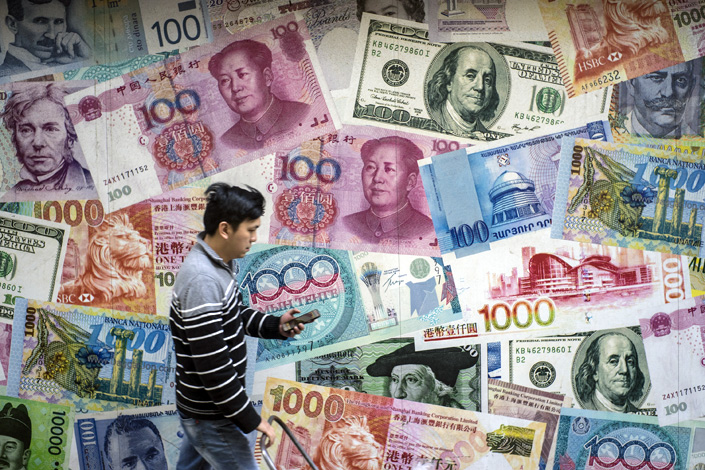Yuan Strengthens after China Announces Plans to Expand Currency Basket

(Beijing) — China’s central parity rate for the yuan against the U.S. dollar strengthened Friday after Beijing announced it will nearly double the number of currencies in the basket that helps determine the yuan’s value — diluting the role of the greenback and the currencies of other developed economies.
The yuan’s benchmark rate was 6.9370 against the dollar on Friday, up 127 basis points from 6.9497 Thursday. The rate is set by the People’s Bank of China (PBOC) based on offers by all market makers before trading opens on each business day.
Friday’s gain came one day after the China Foreign Exchange Trade System (CFETS) said it will increase the number of currencies in the basket it uses to calculate the CFETS RMB Index to 24 from the existing 13 starting on January 1. The CFETS is linked to the central bank and publishes the official rate.
The 11 currencies to be added include the South African rand, the South Korean won, the United Arab Emirates’ dirham and Saudi Arabia’s riyal. They will take a combined share of 21.09% in the mix, the CFETS said in a statement on its website on Thursday.
The weight of the U.S. dollar will, therefore, decline to 22.4% from the current 26.4%, according to the foreign exchange market operator. The weighting of the euro will come down to 16.34% from 21.39% and the yen to 11.53% from 14.68%.
The expansion “will make the basket of currencies more representative because it will include the currencies of all major trade partners of the country,” said the statement.
The CFETS will adjust the composition of the basket and the weight of the currencies on a yearly basis, it added.
The yuan’s central parity rate has depreciated by nearly 7% this year, prompting a surge in capital flight. It is under rising pressure to weaken further next year due to a stronger dollar and growing likelihood of more U.S. Fed interest-rate hikes.
Worried by exacerbating money outflows, Beijing has stepped up efforts to stabilize the yuan’s value, including scaling back its holdings of U.S. Treasury bonds.
Thursday’s move is probably aimed at preventing abrupt slumps in the yuan’s rate against the dollar, while protecting Chinese exporters’ edges, analysts said.
Without the change, the yuan would strengthen against currencies of China’s non-U.S. trading partners in a strong dollar environment due to its semi-peg to the greenback. This would undermine China’s global competitiveness, Jeremy Stevens, a Beijing-based economist with Standard Bank Group, told Caixin.
“In contrast, but also in the case of general USD strength, a shift to the basket in determining the value of CNY should result in a depreciation of CNY/USD along with the rest of the basket,” he said.
But “experience suggests that the PBOC will limit the degree to which the CNY/USD will weaken, otherwise it could trigger capital outflow pressures,” he said.
Societe Generale’s analyst Claire Huang, said the addition of more currencies will make it easier for the central bank to maintain the yuan’s stability against the basket if the euro and the yen weaken faster than money in emerging markets.
Authorities “may have weighed pros and cons under different scenarios,” she said, adding that emerging market currencies strengthened against the euro and the yen after Donald Trump won the U.S. presidency.
Beijing “may have been convinced that volatilities in the euro and the yen will be bigger than other countries’ currencies,” she said.
The yuan’s depreciation pressure is expected to mount in the first quarter of 2017 when the Chinese government releases a number of economic indicators that will likely be distorted by the Spring Festival holiday.
The renewal of an annual quota that limits the amount of foreign exchange residents can obtain to $50,000 per person may worsen the situation, analysts said.
Stevens predicted the yuan could “feasibly breach 7.3” versus the dollar before the end of March, with China’s foreign exchange reserves falling below $2.8 trillion in early 2017, compared with $3.05 trillion as of November.
“However, if the PBOC changes the basket next year — by including more currencies — the path is likely to be more smooth because the aggregate glide path of all the currencies in the basket will be more smooth than the individual crosses,” he said. “This is consistent with officials trying to find a way to project stability in the yuan.”
Contact reporter Fran Wang (fangwang@caixin.com)

- 1Cover Story: How China Inc. Is Discovering Its New World in Brazil
- 2In Depth: A Lost Masterpiece’s Return Exposes Scandal at a Top Chinese Museum
- 3Offshore Yuan Breaches 7.0 Per Dollar to Hit 15-Month High
- 4China Launches $14 Billion State Fund to Back Strategic Tech Industries
- 5In Depth: Memory Shortage Creates Space for China’s Lesser-Known Chipmakers
- 1Power To The People: Pintec Serves A Booming Consumer Class
- 2Largest hotel group in Europe accepts UnionPay
- 3UnionPay mobile QuickPass debuts in Hong Kong
- 4UnionPay International launches premium catering privilege U Dining Collection
- 5UnionPay International’s U Plan has covered over 1600 stores overseas




